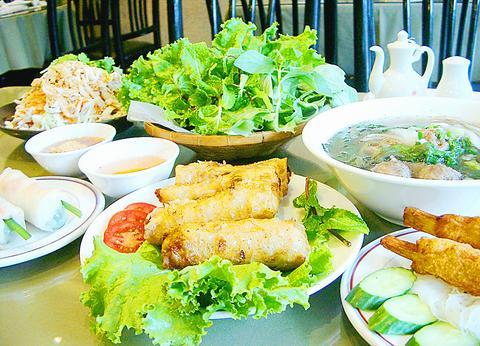Madame Jill's was the first Vietnamese restaurant to come to Taipei, when the Vietnam War was still raging. In 1974, the Lin family (overseas Chinese) moved to Taipei because of the war and set up the first branch of Madame Jill's, across the street from National Taiwan University. Over the past 30 years three other branches have been established and they remain frequently visited spots around the neighborhood.
With southeast Asian food becoming more popular in recent years and with more Vietnamese wives opening their own restaurants in the country, Madame Jill's nevertheless thrives, surviving the economic slump two years ago and the SARS outbreak last year.

PHOTO: YU SEN-LUN, TAIPEI TIMES
Asked if there were any secrets to maintaining the business, Liang Hai-ying (
"You want to make sure that each bowl of pho (rice noodles) tastes the same all the time," she said.
Chicken salad Vietnamese style is a refreshing starter, which is a mixture of shreds of cabbage, cucumber, chicken and carrots and sprinkled with peanut powder. It is then seasoned with fish sauce, a necessity in any Vietnamese dish.
"The fish sauce is the equivalent of soy sauce in Chinese cuisine. You season almost every dish with it," Liang said.
Spring Rolls are another must-try at Madame Jill's. There are two kinds of spring roll skins: Vietnamese style (made of rice) and Taiwanese style (made of flour). For sure, the Vietnamese style tastes better here, despite some local customers' preference for the other. The traditional method of preparation is to wrap the spring roll with a lettuce leaf, adding basil and mint leaves, which is then dipped in a home-made fish sauce. It tastes sweet and sour, and slightly spicy.
Though a bowl of rice noodles with beef in a soup is a often ordered as a main course, it is recommended that you order extra beef meatballs. For a more "colonial taste," one should try spicy coconut beef with French baguette. The bread is home made, Liang said.
Deserts here are a mixture of Thai, Malaysian and Vietnamese. The home-made laya cake is worth-trying, though. It is a green-colored, coconut flavored cake, made with the juice of laya tree leaves, a tropical tree common in Vietnam.

In Taiwan there are two economies: the shiny high tech export economy epitomized by Taiwan Semiconductor Manufacturing Co (TSMC, 台積電) and its outsized effect on global supply chains, and the domestic economy, driven by construction and powered by flows of gravel, sand and government contracts. The latter supports the former: we can have an economy without TSMC, but we can’t have one without construction. The labor shortage has heavily impacted public construction in Taiwan. For example, the first phase of the MRT Wanda Line in Taipei, originally slated for next year, has been pushed back to 2027. The government

July 22 to July 28 The Love River’s (愛河) four-decade run as the host of Kaohsiung’s annual dragon boat races came to an abrupt end in 1971 — the once pristine waterway had become too polluted. The 1970 event was infamous for the putrid stench permeating the air, exacerbated by contestants splashing water and sludge onto the shore and even the onlookers. The relocation of the festivities officially marked the “death” of the river, whose condition had rapidly deteriorated during the previous decade. The myriad factories upstream were only partly to blame; as Kaohsiung’s population boomed in the 1960s, all household

Allegations of corruption against three heavyweight politicians from the three major parties are big in the news now. On Wednesday, prosecutors indicted Hsinchu County Commissioner Yang Wen-ke (楊文科) of the Chinese Nationalist Party (KMT), a judgment is expected this week in the case involving Hsinchu Mayor Ann Kao (高虹安) of the Taiwan People’s Party (TPP) and former deputy premier and Taoyuan Mayor Cheng Wen-tsan (鄭文燦) of the Democratic Progressive Party (DPP) is being held incommunicado in prison. Unlike the other two cases, Cheng’s case has generated considerable speculation, rumors, suspicions and conspiracy theories from both the pan-blue and pan-green camps.

Stepping inside Waley Art (水谷藝術) in Taipei’s historic Wanhua District (萬華區) one leaves the motorcycle growl and air-conditioner purr of the street and enters a very different sonic realm. Speakers hiss, machines whir and objects chime from all five floors of the shophouse-turned- contemporary art gallery (including the basement). “It’s a bit of a metaphor, the stacking of gallery floors is like the layering of sounds,” observes Australian conceptual artist Samuel Beilby, whose audio installation HZ & Machinic Paragenesis occupies the ground floor of the gallery space. He’s not wrong. Put ‘em in a Box (我們把它都裝在一個盒子裡), which runs until Aug. 18, invites